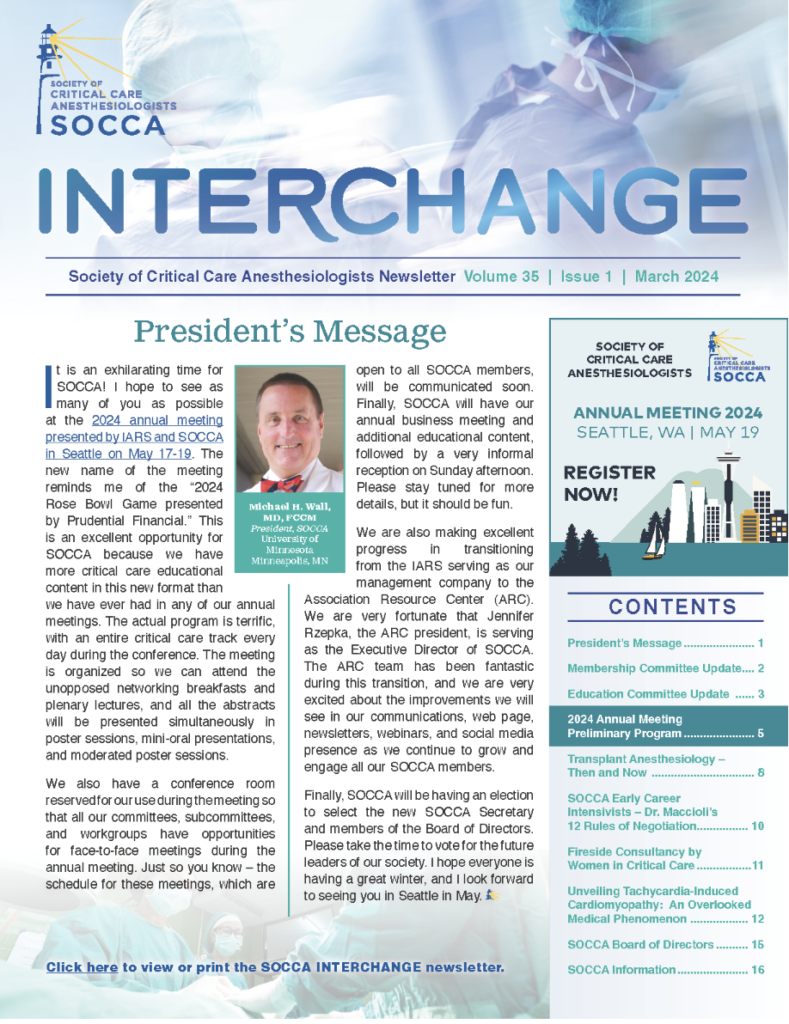Questions Linger About the Clinical Impact of Translating Lung Protective Ventilation into the Operating Room
Landmark trials over the past three decades have fostered appreciation for the potentially injurious effects of mechanical ventilation. Current approaches to lung protective ventilation include the limitation of tidal volumes (VT) to 6 ml/kg PBW, restriction of plateau pressures (Pplat) to no more than 30 cm H2O, and attention to driving pressures. As these practices have become commonplace in the ICU, intraoperative mechanical ventilation has trended toward lower VT and higher positive end expiratory pressure (PEEP).1,2 However, the clinical impact of intraoperative lung protective mechanical ventilation in patients with uninjured lungs remains unclear.
Weingarten et al. reported improved oxygenation and respiratory mechanics in patients undergoing abdominal surgery who received VT 6 ml/kg predicted body weight (PBW), PEEP 12 cm H2O, and recruitment maneuvers (RM) compared to those assigned to VT 10 ml/kg PBW, without PEEP and RM.3 Two multicenter trials in patients undergoing abdominal surgery comparing protective ventilation (VT 6-8 ml/kg, PEEP ≥ 5, repeated RM) with more conventional ventilation (large VT, no PEEP or RM) demonstrated a reduced risk of postoperative pulmonary and extrapulmonary complications in their respective intervention groups.4,5 It is not possible, however, to ascertain which of the bundled interventions was responsible for the reported improvement in outcomes.
Is there an optimal intraoperative PEEP?
Atelectasis is reported in up to 90% of patients undergoing general anesthesia, especially when accompanied by neuromuscular blockade.6 This leads to heterogenous distribution of collapsed and overdistended areas in lungs of anesthetized patients. While mechanical ventilation with small VT without PEEP can promote atelectasis formation and cyclic opening and closing of alveoli, the optimal level of intraoperative PEEP is not well defined, and it remains unclear whether improved oxygenation and respiratory mechanics lead to improved clinical outcomes. Multiple pro- and retrospective studies have addressed this issue, and their findings are equivocal.
In an observational study of patients undergoing major abdominal surgery and those undergoing craniotomies, application of PEEP ≥ 5 cm H2O was associated with decreased incidence of postoperative pulmonary complications (PPC) compared to the application of PEEP < 5 cm H2O.7 Of interest, while application of PEEP > 5 cm H2O reduced the incidence of PPC and hospital length of stay in patients undergoing major abdominal surgery, these findings were not observed in patients undergoing craniotomy. A systematic review and individual patient data meta-analysis showed reduced incidence of PPC in patients assigned to low VT and PEEP ≥ 5 cm H2O.8 There was no difference in the incidence of PPC between patients who received low VT with low PEEP and those who received low VT and high PEEP. In total, these findings suggested that relatively low, but nonzero, levels of PEEP are likely appropriate for most non-obese patients, and that the routine application of PEEP may prevent postoperative pulmonary complications in vulnerable patient groups, such as those undergoing abdominal surgery.
Are recruitment maneuvers valuable?
Given the equivocal findings about PEEP in isolation, the question arises as to whether or not PEEP titration in isolation can overcome dense atelectasis. The combination of RM and PEEP is increasingly commonplace in ARDS protocols aiming to determine the optimal PEEP, and their combination has been shown to improve oxygenation in critically ill adults.
However, in a multicenter RCT of non-obese patients undergoing open abdominal surgery, no difference was demonstrated in the incidence of PPC between patients assigned to PEEP 0-2 cm H2O without RM and those assigned to PEEP 12 cm H2O with RM. All patients were ventilated with VT of 8 ml/kg PBW (9). In a second recent RCT obese patients undergoing laparoscopic or non-laparoscopic surgery expected to last at least 2 hours were randomized to receive 12 cm H2O of PEEP and frequent RM compared to 4 cm H2O of PEEP and no RMs. All patients received volume controlled mechanical ventilation with VT of 7 ml/kg PBW. Similarly, there was no reduction in the incidence of PPC within the first five postoperative days.10 Fewer patients randomized to the high PEEP and RM strategy experienced hypoxemia, however.
The findings from these studies suggest that high levels of PEEP with frequent RM provide no additional protective benefit in patients with uninjured lungs who undergo mechanical ventilation for elective surgery.
Are we examining the wrong variables?
To further complicate matters, a recent meta-analysis of individual patient data from 17 RCT of lung protective ventilation during general anesthesia for surgery suggested that driving pressure (ΔP), a variable that is associated with lung strain and calculated as Pplat - PEEP, was the only variable associated with the development of PPC, while VT and PEEP did not affect the incidence of PPC.11 A similar finding was also observed in a meta-analysis of individual patient data from 3562 patient with ARDS. Driving pressure was the only ventilation variable that was associated with survival, even among the patients that received lung protective VT and plateau pressures, and VT and PEEP affected mortality only if they led to a reduction in driving pressure.12 A recent prospective RCT comparing ΔP guided protective ventilation versus conventional lung protective ventilation (VT 6 ml/kg PBW, PEEP 5 cm H2O) during one-lung ventilation in patients undergoing thoracic surgery showed reduced incidence of PPCs in the intervention group.13 It should be noted that the variables that define ΔP are themselves highly predictive of survival. Therefore, it remains unclear whether ΔP is simply a marker of lung compliance or a variable that we should routinely target to optimize intraoperative lung ventilation.
Conclusions
Despite conflicting evidence as to its clinical impact, lung protective mechanical ventilation is increasingly employed in the operating room. While ventilation with reduced VT has improved mortality in patients with ARDS, the impact of intraoperative lung protective ventilation on clinical outcomes, in patients with non-injured lungs undergoing elective surgery, is not as clear. While earlier trials of protective ventilation with small VT, high PEEP, and frequent RM demonstrated improved clinical outcomes in high risk patients undergoing abdominal surgery, more recent trials question the benefit of high PEEP during laparoscopic and non-laparoscopic abdominal surgery, as well during craniotomy.7,9,10 The Severinghaus Lecture on Translational Science at the annual Anesthesiology meeting this year by Dr. Jeanine Wiener-Kronish pertained to personalized PEEP and included discussion of the potential role of electrical impedance tomography in ascertaining individualized ideal PEEP. Also pertinent was her assertion that critical care anesthesiologists are uniquely poised to contribute to further advances in the domain of lung protective mechanical ventilation.
References
- Wanderer JP, Ehrenfeld JM, Epstein RH, et al. Temporal trends and current practice patterns for intraoperative ventilation at U.S. academic medical centers: a retrospective study. BMC Anesthesiol 2015;15:40.
- Intraoperative lung-protective ventilation trends and practice patterns. Anesth Analg. 2015;121:1231-1239.
- Weingarten TN, Whalen FX, Warner DO, Gajic O, Schears GJ, Snyder MR, et al. comparison of two ventilatory strategies in elderly patients undergoing major abdominal surgery. Br J Anaesth 2010;104:16-22.
- Futier E, Constantin JM, Paugam-Burtz C, et al. A trial of intraoperative low-tidal volume ventilation in abdominal surgery. N Engl J Med 2013;369:428-437
- Severgnini P, Selmo G, Lanza C, et al. Protective mechanical ventilation during general anesthesia for open abdominal surgery improves postoperative pulmonary function. Anesthesiology 2013;118:1307-21
- Hedenstierna G, Rothen HU. Atelectasis formation during anesthesia: Causes and measures to prevent it. J Clin Monit Comput. 2000;16:329-35
- De Jon MAC, Ladha KS, Vidal Melo MF, et al. Differential effects of positive end-expiratory pressure (PEEP) on respiratory outcome in major abdominal surgery versus craniotomy. Ann Surg 2016;264:362-69
- Serpa Neto A, Hemmes SN, Barbas CS, et al. PROVE Network Investigators. Protective versus conventional ventilation for surgery: A systematic review and individual patient data meta-analysis. Anesthesiology 2015;123:66-78
- Hemmes SN, Gama de Abreu M, Pelosi P, Schultz MJ, et al. High versus low positive end-expiratory pressure during general anaesthesia for open abdominal surgery (PROVHILO trial): a multicentre randomised controlled trial. Lancet 2014;384:495-503
- Bluth T, Serpa Neto A, Schultz MJ, Pelosi P, Gama de Abreu M, et al. JAMA. 2019;321(23):2292-2305.
- Serpa Neto A, Hemmes SN, Barbas CSV, et al. Association between driving pressure and development of postoperative pulmonary complications in patients undergoing mechanical ventilation for general anesthesia: A meta-analysis of individual patient data. Lancet Respir Med 2016;4:272-80
- Amato MPB, Meade OM, Slutsky AS, et al. Driving pressure and survival in the acute respiratory distress syndrome. NEJM 2015;372:747-55
- Park M, Ahn HJ, Kim JA, et al. Driving pressure during thoracic surgery: A randomized controlled trial. Anesthesiology 2019;130:385-93




































